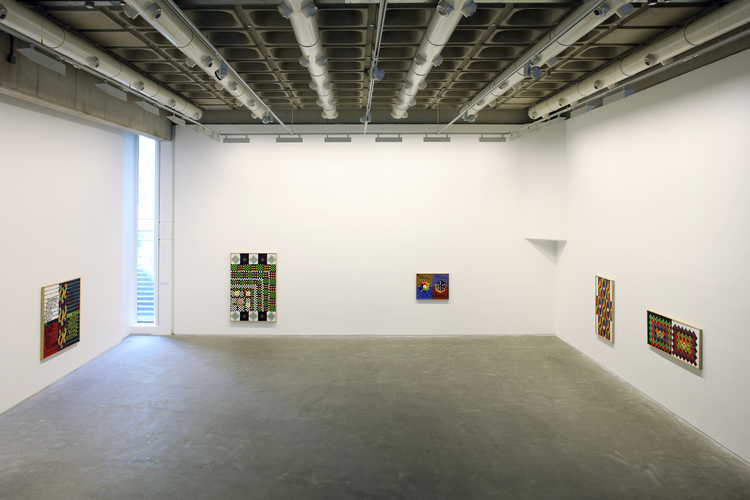
The Douglas Hyde Gallery is small compared to the Hugh Lane Gallery or National Gallery of Ireland. It has a comparatively simple layout. There are no maze-like corridors here, just one large, central chamber and a single side room. Its size, layout and location inside Trinity’s Nassau Street entrance make it an ideal place to spend a spare hour on campus viewing some great contemporary art.
The Douglas Hyde Gallery has two temporary exhibits at any given time. The current ones run until December 2nd. In the central chamber, fourteen works by the New York-based artist, Chris Martin are scattered around the room. His paintings are vibrantly coloured and often covered in glitter. They’re rarely flat. Martin’s work incorporates three-dimensional elements, especially cylinders. A few paintings might be as aptly described as sculpture.
The gallery mentions that he was influenced by popular culture and psychedelia. Fans of the latter will recognise a few of the famous images that he has cut from magazines or newspapers and incorporated into his pieces. In my favourite work on display, Martin has made a collage of newspapers on a large canvas, spray-painted it red and highlighted some areas in yellow circles. In one area, he’s a hole in the canvas that seems to offer a peek into an area beneath the work, but actually just contains more newsprint. It’s a puzzling yet wonderful painting which appropriately features newspaper puzzles like Sudoku and crosswords in the collage. His selection of headlines is particularly striking, most of which appear to be drawn from tabloids – “DEATH CASE” declares one, “Who is Obama’s Real Father?” another.
The way Martin uses circles is common to almost all of the work on display. Martin has created Styrofoam cylinders, painted them and attached them to the piece in many works, and circles simply occupy prominent places in the composition in others. They’re boldly coloured in oranges and yellows. The focus is most apparent in one work that displays records arranged in an order on a canvas, most of which have been painted with white, circular dots.
In the side room, a much more densely packed exhibition entitled “Sticks” is on display by Seanie Barron, and artist from County Limerick. They show consists of walking sticks that have been deliberately crafted with motifs of Irish animals, plants and some more abstract forms. Their heads are often suggestive of animals like badgers, dogs, deer and birds. Their shafts sometimes feature very intricate designs. One beautiful stick is carved so that part of the shaft is a helix.
Given that Barron has obvious, immense technical skill, it’s interesting to consider the sticks which are left in rougher shape, where it’s obvious branches have been removed, leaving the process of his art less hidden. Undoubtedly visitors will focus on walking sticks that are the most finely crafted, like one with an astonishingly well-carved badger’s head, but it’s worth looking too at the sticks where the animal or plant motif isn’t obvious or where it’s only subtly suggested. I love a particular stick which has a head similar to a goat. The snout is too long, the horns are at odd angles and the eyes have been gouged out of the wood, giving it a certain charm.
It is a cliché of journalism when faced with two radically different exhibits in one place to connect them in review. Unfortunately, I don’t see an obvious connection between the two exhibits on display in the Douglas Hyde Gallery. It was apparent during my visit that different kinds of people were going to Martin’s and Barron’s exhibitions. If anything, this is a strength of the gallery. Your interests might lie in one exhibit or the other, but they’re different enough to entice students and visitors through their doors. With free entry, and a perfect location beside the arts block means it’s the perfect place to spend your spare hour, whether you’re an art fan or not.






